
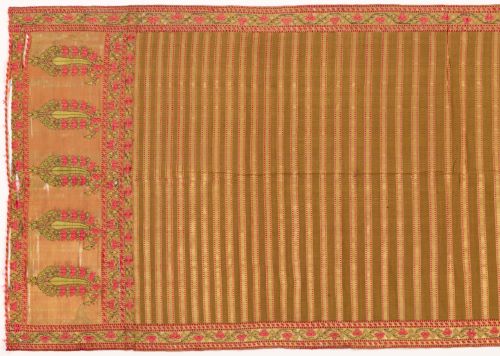
The centuries-old caste-based division of labor has continued to underpin formal arrangements.

Provided by The Map Academy
Introduction
The community-based production of handcrafted textiles across the Indian subcontinent has fostered generations-long engagement with techniques and materials that are rooted in the ancient caste system, a hierarchical social order that accords communities with specific jatis or castes based on their traditional occupations. This system enforced strict demarcations, confining people to their designated social groups, professions, and status.
Over the years, the centuries-old caste-based division of labor has continued to underpin the formal arrangements of textile practices that emerged as a response to increasing commercial demands, overseas trade, and royal patronage. We see this most prominently in the 16th and 17th centuries when establishments such as karkhanas or imperial workshops and weavers’ associations reorganized prevailing systems of textile production, granting groups of artisans better access to raw materials, new technologies, and, ultimately, greater economic and social mobility. In this topic, we explore two examples that emerged simultaneously in different parts of the subcontinent.
Mughal ‘Karkhanas’: Cross-Cultural Interactions
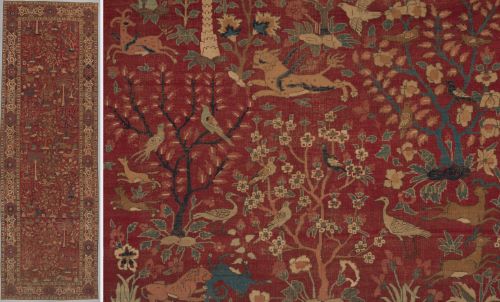
While karkhanas were operating in the Indian subcontinent since the 13th-century Tughlaq dynasty, textile production in these workshops became especially popular during the time of the Mughal emperor, Akbar, in the 16th century. Akbar set up karkhanas in Lahore, Agra, and Ahmedabad, which hosted entire communities of weavers, embroiderers, dyers, and printers who produced textiles exclusively for the needs of nobility as well as for trade. In these workshops, artisans were provided with the tools, equipment, raw materials, and capital to produce exquisite silks, Pashminas, and muslins, among other textiles.
The Tughlaq dynasty of the Delhi Sultanate was founded by Giyath-al-din Tughlaq in 1320, providing stability after a series of chaotic events following the end of the previous Khalji dynasty. It was his son, Muhammad bin Tughlaq, who first as prince and governor and then as the Sultan, expanded the empire to the interiors of the Deccan. For a brief time, the capital was shifted from Delhi to Daulatabad in modern day Maharashtra. The next sultan, his cousin Firuz Shah Tughlaq, preferred to focus on building stability within the empire rather than on expansion and built a number of canal works for aiding irrigation around modern-day Haryana. After his death, the Sultanate would never rise to these heights of power as civil wars and invasion by Timur, founder of the Timurid Empire, would leave the kingdom broken.
Pashmina is handwoven cloth from the Kashmir region of the Indian subcontinent. The fleece used to make the cloth is known as pashm, meaning “soft hair” in Persian, and is usually gathered from the soft undercoat of Himalayan goats. This wool cloth is now sometimes known as “cashmere” after the old English spelling of “Kashmir,” or as “pashmina” from the word “pashm.”
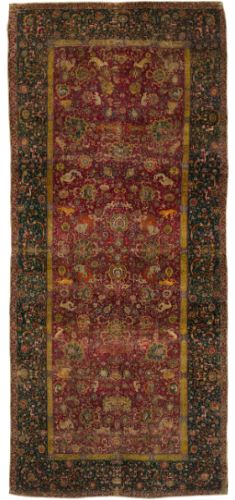
Master weavers were invited from other regions, especially Safavid Iran, to train these local artisans in specialized techniques such as brocade and carpet weaving. The karkhanas effectively served as spaces that encouraged the exchange of ideas and technical practices among artisans of diverse backgrounds. These interactions led to valuable innovations and prominent cross-cultural influences that reflected in the making and the appearance of the textiles. Brocade and carpet designs produced by the Mughals, for instance, were aesthetically similar to Safavid textiles depicting Persianate motifs, such as hunting scenes (shikargah), scrolling vines, and other floral designs. These textiles became so popular within and outside the subcontinent that textiles soon became the most valued commodities in the karkhana system—which also produced a range of craft items, manuscripts, and paintings—and one of the most important sources of revenue for Mughal rulers.
Weavers’ Associations: Hubs of Urban Development
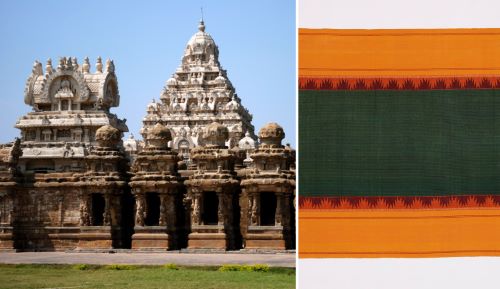
Around the same time, southern India saw the emergence of a very different system of work for textile artisans. Here, the Vijayanagara, Chola, and Nayaka rulers encouraged several communities of weavers to migrate to the newly built towns in their kingdoms, offering them patronage and residential spaces to live and work. These migrant weaver communities settled around important temples, which eventually formed the locus of the town’s cultural and social life. As a result, the history of these South Indian towns is intricately linked to the emergence of weavers’ associations. These groups loosely resembled workers’ guilds, controlling the production and trade of certain crafts and representing the political, social, and economic interests of their members in courts and markets. Weavers’ associations functioned in similar ways, providing raw material, training, and financial assistance to weaving communities. In addition to producing textiles for their royal patrons, they were also commissioned by priests to weave for temple deities, a task that granted them upward social mobility.
The Chola empire ruled much of present-day south India from c. 848 until 1279. One of the longest lasting empires of south India, the Cholas heralded a golden age of exploration, trade, and artistic development. The Vijayanagara Empire had a number of landed governors and military generals called Nayakas. These governors started to establish independent kingdoms all over southern India after the battle of Talikota which had left the Empire virtually powerless. Ikkeri and Odeyars in northern Karnataka; and Ginjee, Madurai and Thanjavur in modern Tamil Nadu were among the powerful kingdoms which later vied for power during the invasions by Deccan Sultanates and the Mughals until the coming of the British.
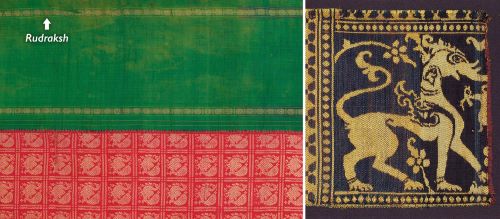
Their proximity to the temples further inspired them to incorporate decorative elements from temple architecture into their textiles, including motifs such as Yali, Rudraksh, and temple borders. Furthermore, these associations facilitated networks of communication between master weavers and merchants, allowing textile artisans to participate directly in domestic and overseas trade. Over time, these associations contributed to the transformation of these towns from religious centers into hubs of commerce, trade, and urban life.
Yali is a mythical creature who features in textile traditions like Kanjivaram. Dating back to ancient India, Yali symbolizes protection and is represented as part-lion at the body, part-horse at the head, and part-elephant with the tusks. It has been in use since the earliest sculpted Pallava dynasty (3rd–9th centuries C.E.) temples. In the Kanjivaram saris, it is often coupled with the peacock or annam to balance the symbolism.
Rudraksha (literally, eyes and tears of Rudra/Shiva) are beads which have religious significance for Hindus. Mostly used in borders or pallus of saris instead of the body, it has aesthetic, sacred and symbolic purposes. In the motif, one finds a center surrounded by petals and is used in Kanjivaram saris, Gadwal in Andhra Pradesh and Telangana, and in hand-woven fabrics of Odisha.
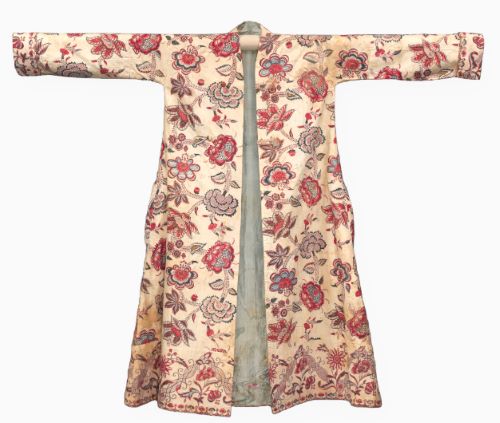
Factors such as migration, patronage, and trade have influenced many forms of existing, caste-based textile practices across the Indian subcontinent. In addition to the literal reorganization of labor, these influences can also be evidenced by cross-cultural confluences in technology, technique, and design vocabulary. Contemporary systems of work in the subcontinent have evolved across generations, with aspects of their structures and pedagogical setups dating back centuries. While the intergenerational nature of such community-based textile production has encouraged distinct relationships between makers and their practices and has kept age-old traditions alive, its ties to the caste system have also resulted in the severe economic and social marginalization of certain textile communities that have been deemed “lower caste.”
Discrimination on the basis of caste was legally abolished in India in 1950, and newer generations of some textile communities have begun to move away from their inherited occupations in pursuit of better opportunities. Despite the legal measures taken to safeguard the rights of marginalized groups, however, the caste system continues to be prevalent in the subcontinent, impacting the economic and social lives of several communities. Regardless, textile artisans also remain preservers of ancient traditions and practices, with many taking pride in the inimitability, complexity, and uniqueness of their work.
Additional Resources
- Take a short course on Textiles from the Indian Subcontinent with The MAP Academy
- R. Champakalakshmi, “Growth of Urban Centers in South India: Kudamukkupalaiyarai, The Twin City of the Cholas,” Proceeding of the Indian History Congress, volume 39 (1978), pp. 168–79.
- Katie Currie, “The development of petty commodity production in Mughal India,” Bulletin of Concerned Asian Scholars, volume 14, number 1 (1982), pp. 16–24.
- Boni Dutta, “An Insight into the different types of Mughal Karkhanas,” Journal of Emerging Technologies and Innovative Research, volume 5, number 7 (2018), pp. 1178–80.
- Richard A. Frasca, “Weavers in Pre-Modern South India,” Economic and Political Weekly, volume 10, number 30 (1975), pp. 1119–23.
- Irfan Habib, “Potentialities of Capitalistic Development in the Economy of Mughal India,” The Journal of Economic History, volume 29, number 1 (1969), pp. 32–78.
- Vijaya Ramaswamy, “Silk and Weavers of Silk in Medieval Peninsular India,” The Medieval History Journal, volume 17, number 1 (2014), pp. 145–69.
- Vijaya Ramaswamy, Textiles and Weavers in Medieval South India (Dehli: Oxford University Press, 2016).
- Vijaya Ramaswamy, “Migration of the Weaver Communities in Medieval Peninsular India, Thirteenth to the Eighteenth Century,” Migration in Medieval and Early Colonial India (New York: Routledge, 2016).
- Albert James Saunders, “The Saurashtra Community in Madurai, South India,” The American Journal of Sociology, volume 32, number 5 (1927), pp. 787–99.
Originally published by Smarthistory, 01.09.2024, under a Creative Commons Attribution-NonCommercial-ShareAlike 4.0 International license.


